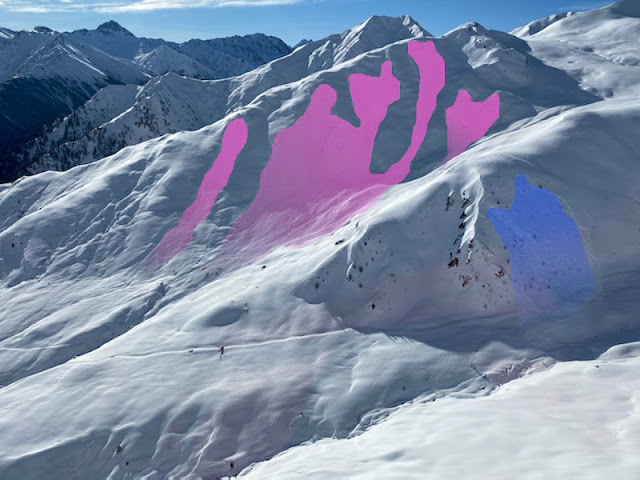Again today, 04.02.2022, numerous avalanches involving persons were reported to headquarters. In one avalanche in the Samnaun Massif near Fliesser Stieralpe, 5 people were killed. In other avalanches at Steinalm near Aurach in Kitzbühel and in Rettenbachtal, Sölden, persons were gravely injured.
Avalanche Accident Fliesser Stieralpe
The avalanche accident occurred during the descent of a group of skiers who were coming from the Silvretta Skiarena on their way to Spiss. It was a large-sized slab avalanche. The cause lay in a combination of fresh snow and persistent weak layer. Further details of the accident will be ascertained together with the Alpine Police tomorrow, then published as soon as possible in a new blog.
 |
| Overview of Fliesser Berg. in magenta: the fatal avalanche; in blue: another slab avalanche (photo: 04.02.2022 (c) Alpine Police) |
 |
| Enlarged area of the fatal avalanche Fliesser Berg (c) tiris |
Caution: combination of fresh snow + persistent weak layer in some areas
A rough analysis of the avalanches thus far results in the following picture: During a short period of snowfall and storm winds, it was very often the weak layers (near the prior old-snowpack surface and inside the fresh fallen snow) which were decisive for the avalanches. Frequently in the latter case there were massive layers of graupel embedded in the new snow. In the meantime the problem has shifted more and more in the direction of weak layers in the old snowpack surface. As referred to in the 27.01.2022 Blog, there often were crusts and, beneath them, highly sensitive faceted crystals. Such weak layers are often interconnected and thereby lead to wide-area slab avalanches (persistent weak layer). This problem occurs often in shady terrain near forest clearances and at forest rims above 2700 m. From the vicinity of the accident (western Main Ridge) we also know from snowpack analysis that it frequently found the old snowpack was expansively metamorphosed in its entirety and thus, extremely loose.